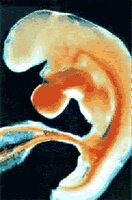 Last week, the fertilized egg has divided into hundreds of cells and is now called a blastocyst. The blastocyst is hollow and filled with fluid, if now he could see inside your uterus, would hardly be visible.
Last week, the fertilized egg has divided into hundreds of cells and is now called a blastocyst. The blastocyst is hollow and filled with fluid, if now he could see inside your uterus, would hardly be visible. Around the third week (usually between 4 and 7), the blastocyst is implanted in the endometrium, the lining of the uterus. Implantation in the uterus is an essential connection, the endometrium will provide nutrients to the developing embryo and eliminate waste. Over time, this implantation site will become the placenta. During pregnancy, the placenta nourishes and protects your developing baby.
already spent a week after fertilization. The blastocyst begins to secrete hormones that prevent your body from releasing the endometrial tissue in the uterus, so you may see that you had your period.
Adequate intake of vitamins, especially folic acid, protein, calcium and iron is essential for nourishing your baby. A folic acid supplement, which, ideally, will have been taking since before conception is particularly important because folic acid helps prevent neural tube defects (head, vertebral column and related structures) formed very early in pregnancy. If not consumed folic acid before please do not be alarmed, consult your doctor who will reset you some extra insurance.
protein intake, which is used to create new tissue, should be doubled during pregnancy should eat at least 60 grams per day. In addition, calcium is needed, at least 1,200 milligrams, for the development of bones and teeth, so be sure to eat a good amount of dairy products, leafy green vegetables. Iron is essential during pregnancy and supporting the continued growth of your baby's blood volume.
Below some anatomy the third week of pregnancy:
invagination of ectodermal cells continues and begin to migrate into the lamina procordal, forming a tube-like extension, called a notochord extension (precursor of the intervertebral discs). In the trilaminar disc flow will form the cloacal membrane (precursor of the year). In addition, they form a small tube, called a duct neuroentérico.
The embryonic disk, which is the initial stage is flat and round, gradually becomes longer and longer for the eighteenth day has a broad head end a narrow caudal end. At this stage, growth occurs mainly embryonic disc in the head region.
0 comments:
Post a Comment